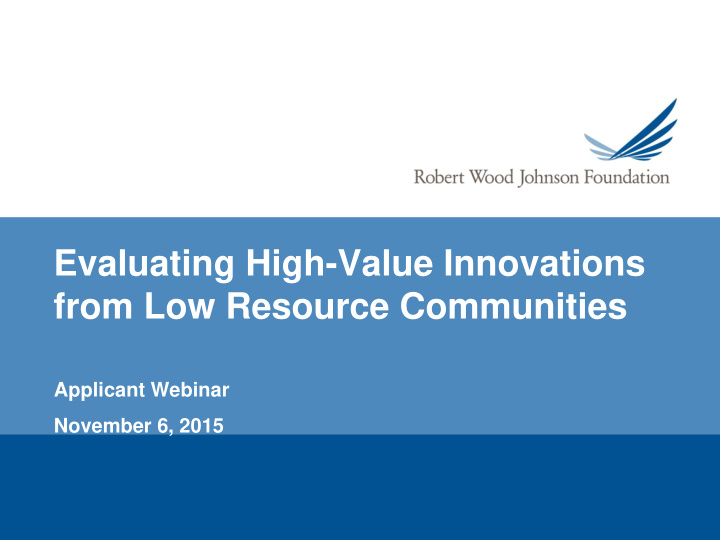



Evaluating High-Value Innovations from Low Resource Communities Applicant Webinar November 6, 2015
A Culture of Health .
Purpose • To identify promising innovations to improve health in low-resource communities • To evaluate whether the innovations improve health care and health outcomes without increasing costs • To disseminate information about successful innovations to other communities
What we’re looking for Evaluations of innovations that are set in and meant to benefit the health of people living in a low-resource community • May be a geographic region OR a specific target population Of particular interest: • Innovations set in rural areas • Innovations meant to benefit adults or children with complex medical and social needs
What we’re looking for (p2) Innovations intended to substantially improve a pressing health problem • Disruptive! Of particular interest: • Better integration of health care, public health, social services • Decreasing use of wasteful or redundant care • Increasing use of high-value care
What we’re looking for (p3) Innovations that are consumer focused and that recognize consumers as important arbiters of care Of particular interest: • Health-related goals of consumers, caregivers and communities • Consumers have the influence, tools and ability to play an integral part in staying healthy and defining and receiving high-value care • Including consumers in decisions about local health care, public health and social service systems
Mechanisms of interest • Further areas of interest • New roles for individuals and organizations within the health care system (e.g., paramedics, community health centers…) • New roles for individuals and organizations outside of the health care system (e.g., social services, early childcare providers, schools…) • Peer-to-peer models of support and self advocacy • New payment models • See pages 2-3 of CFP for additional examples
Evaluation Questions • What was the innovation and how was it implemented? • How did consumers respond to and experience the innovation? • Did the innovation improve the quality of health care provided to consumers? • Did the innovation improve consumers’ health outcomes and quality of life? • Did the innovation affect expenditures for relevant health and/or health care costs? • Potential for replication and expansion of innovation.
Eligibility Criteria- Organizations and Activities Organizations: • Preference given to 501(c)3 organizations. • Applicant organizations must be based in the U.S. Activities: • 80% of funding must go to evaluation activities • Previously untested innovations • Disruptive innovations
Eligibility Criteria- Settings • If defined geographic area, at least 20% of population must be living at or below the Federal Poverty Level • Geographic area must contain at least 25,000 people. • If a specific population not defined by geography, applicant describes why population is low-resource • Income • Poverty status • Educational attainment • Linguistic or cultural isolation • General geographic setting • Other relevant indicators
Selection Criteria • Potential to build knowledge about high-value innovations • Strong interest in rural communities (not a requirement) • Strength and suitability of evaluation design • Measures cost, efficiency or quality outcomes • Fit, quality and availability of proposed data sources • Qualifications of proposed project team • Willingness to disseminate findings • Appropriateness of budget and timeline
Award Information • Up to $2.5 million will be awarded • Individual awards will range from $250k to $400K • Funding awarded for up to 24 months • Up to 10 evaluations will be funded
How to apply • Online at: www.rwjf.org/cfp/ivc • Timeline: • December 10 th at 3:00 pm ET Brief proposals due • Early February Notifications sent • March 22 nd at 3:00 pm ET Full proposals due • Late April Notifications sent • July 15 th Grants begin
Questions? Please contact: Leslie Foster, Director of Health Research Mathematica Policy Research Phone: (510) 830-3709 (Pacific Time) Email: IVC@mathematica-mpr.com 14
- THANK YOU
To determine poverty level in a geographic area • Please follow these steps to determine whether the innovation proposed for evaluation is set in a poverty area as defined by the U.S. Census Bureau: • Go to the FFIEC search tool provided by the Census FactFinder: https:geomap.ffiec.gov/FFIECGeocodeMap1.aspx. • Enter an address in the innovation’s target area in the search bar at the top; click “Search” • The census tract code for that address appears in the “Matched Address” box on the left • Click “Census Demographic Data”, then click the “Income” tab in the pop-up box • Locate the “% Below Poverty Line” statistic. If it is 20% or greater, the address is in “poverty area” and you are eligible to apply .
To determine population size Please follow these steps to determine whether the innovation is set in an area with a population of at least 25,000 people: • Go to the American FactFinder Community Facts search tool: http://factfinder.census.gov/faces/nav/jsf/pages/index.xhtml. • Enter the name of a city, town, county, or zip code in the search box • Choose the appropriate autofill location, click “Search” • The community facts page for that location appears with population estimates from 2010 and 2014 census data
Recommend
More recommend